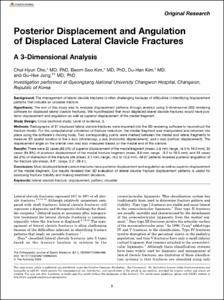KUMEL Repository
1. Journal Papers (연구논문)
1. School of Medicine (의과대학)
Dept. of Orthopedic Surgery (정형외과학)
Posterior Displacement and Angulation of Displaced Lateral Clavicle Fractures: A 3-Dimensional Analysis
- Keimyung Author(s)
- Cho, Chul Hyun; Kim, Beom Soo; Kim, Du Han
- Department
- Dept. of Orthopedic Surgery (정형외과학)
- Journal Title
- Orthopaedic Journal of Sports Medicine
- Issued Date
- 2020
- Volume
- 8
- Issue
- 11
- Keyword
- lateral clavicle fracture; displacement; pattern; shoulder
- Abstract
- Background:
The management of lateral clavicle fractures is often challenging because of difficulties in identifying displacement patterns that indicate an unstable fracture.
Hypothesis:
The aim of this study was to evaluate displacement patterns through analysis using 3-dimensional (3D) rendering software for displaced lateral clavicle fractures. We hypothesized that most displaced lateral clavicle fractures would have posterior displacement and angulation as well as superior displacement of the medial fragment.
Study Design:
Cross-sectional study; Level of evidence, 3.
Methods:
Radiographs of 37 displaced lateral clavicle fractures were imported into the 3D rendering software to reconstruct the fracture model. For the computational simulation of fracture reduction, the medial fragment was manipulated and returned into place using the software's moving tools. Two corresponding points were marked between the medial and lateral fragments to measure 3D spatial location in the x-axis (shortening), y-axis (horizontal displacement), and z-axis (vertical displacement). The displacement angle on the cranial view was also measured based on the medial end of the clavicle.
Results:
There were 32 cases (86.5%) of superior displacement of the medial fragment (mean, 5.8 mm; range, –6.5 to 19.0 mm), 35 cases (94.6%) of posterior displacement of the medial fracture fragment (mean, 8.8 mm; range, –3.2 to 18.3 mm), and 23 cases (62.2%) of distraction of the fracture site (mean, 2.1 mm; range, –9.2 to 12.2 mm). All 37 patients revealed posterior angulation of the fracture site (mean, 8.9°; range, 2.2°-39.4°).
Conclusion:
Most displaced lateral clavicle fractures have posterior displacement and angulation as well as superior displacement of the medial fragment. Our results revealed that 3D evaluation of lateral clavicle fracture displacement patterns is useful for assessing fracture stability and making treatment decisions.
- Publisher
- School of Medicine (의과대학)
- Citation
- Chul-Hyun Cho et al. (2020). Posterior Displacement and Angulation of Displaced Lateral Clavicle Fractures: A 3-Dimensional Analysis. Orthopaedic Journal of Sports Medicine, 8(11), 2325967120964480. doi: 10.1177/2325967120964485
- Type
- Article
- ISSN
- 2325-9671
- Source
- https://journals.sagepub.com/doi/10.1177/2325967120964485
- Appears in Collections:
- 1. School of Medicine (의과대학) > Dept. of Orthopedic Surgery (정형외과학)
- 파일 목록
-
-
Download
 oak-2020-0779.pdf
기타 데이터 / 462.83 kB / Adobe PDF
oak-2020-0779.pdf
기타 데이터 / 462.83 kB / Adobe PDF
-
Items in Repository are protected by copyright, with all rights reserved, unless otherwise indicated.